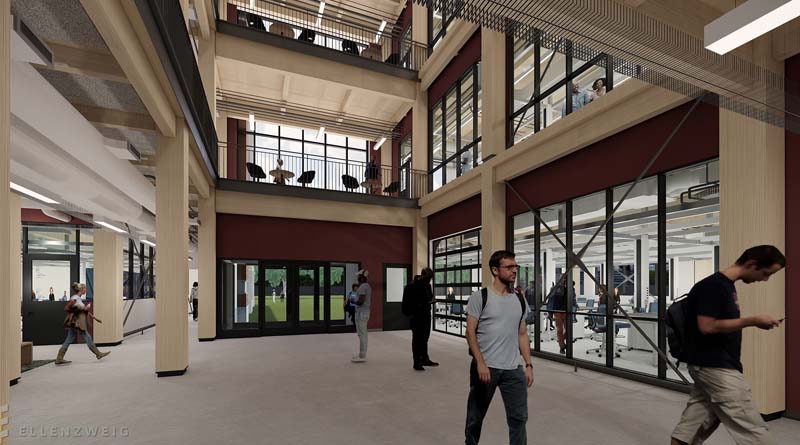By Aziza Jackson
EAST LANSING, Mich. — Michigan State University’s future STEM Teaching and Learning Facility will be the first in Michigan to use an innovative wood product, rather than concrete and/or steel, for its load-bearing structure.
Known as mass timber, this framing style uses large solid or engineered wood. The $100 million facility will be constructed of glue-laminated wooden columns and cross-laminated timber, or CLT, a relatively new product for the floors and ceilings.
“As a leading public research university, MSU has the fantastic opportunity to showcase these innovative and sustainable construction methods in the state of Michigan,” said Satish Udpa, MSU’s acting president. “I am delighted to see university operations, including building construction, pull from our state’s history as a lumber leader and mesh with the engineering capabilities of advanced materials.”
CLT is a wood panel made from gluing layers of solid wood at cross-grain to result in a lightweight and strong panel. It’s been used in Europe for more than 20 years, with recent interest in Canada and the U.S., especially on the West Coast.
“We compared mass timber with other framing methods and were intrigued by how far wood has come as a building material,” said John LeFevre, MSU’s Planning, Design and Construction director. “A major advantage is the speed of construction – the panels can be assembled very quickly.”
The new building will be constructed around the former Shaw Lane Power Plant, adjacent to Spartan Stadium. The renovation will include a student science studio space and a vibrant commons area with a cafe. Two new mass timber wings will offer 117,000 square feet of modern teaching labs, responding to STEM course demand, which has increased 40 percent in the last 10 years at MSU. The project architect is IDS with Ellenzweig Architecture, IDEO Design and Sasaki Design. Granger Construction Company is the construction manager.
The pleasing aesthetics of exposed wood also create a warm, inviting and atypical environment for learning science.
“I am excited to see the educational, research and outreach opportunities that the building itself promises to many academic units and to our land-grant mission,” said Ron Hendrick, dean of MSU’s College of Agriculture and Natural Resources. “It is an interdisciplinary platform encompassing forestry, construction management, biosystems engineering and beyond, and can serve as a catalyst to develop this new technology in Michigan.”
Many believe the MSU building will catalyze additional mass-timber construction in the state, which might lead to establishing CLT manufacturing in Michigan.
“Michigan is ideally situated to become a leader in mass-timber manufacturing,” said Mark Rudnicki, Michigan Forest Biomaterials Institute executive director. “We have abundant forest resources that are managed sustainably and the manufacturing know-how. But there is not a building CLT manufacturer in the central U.S.”
Michigan DNR officials agree.
“Having a CLT manufacturer in Michigan would not only create green jobs using sustainable resources, but also provide the financial resources and incentives that are needed to restore and conserve healthy, diverse and productive forests that provide so many other benefits,” said Debbie Begalle, state forester and chief of the Forest Resources Division of the Michigan Department of Natural Resources.
The building is slated to open in fall 2020 with classes beginning in January 2021. The wood panels are being manufactured in Quebec and will arrive on campus in April.


